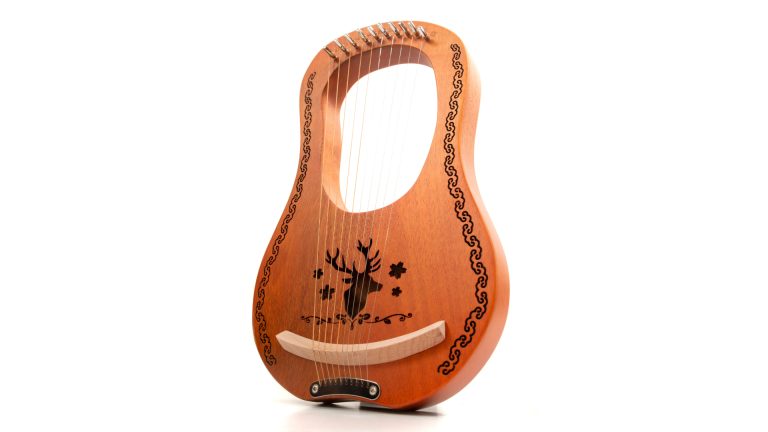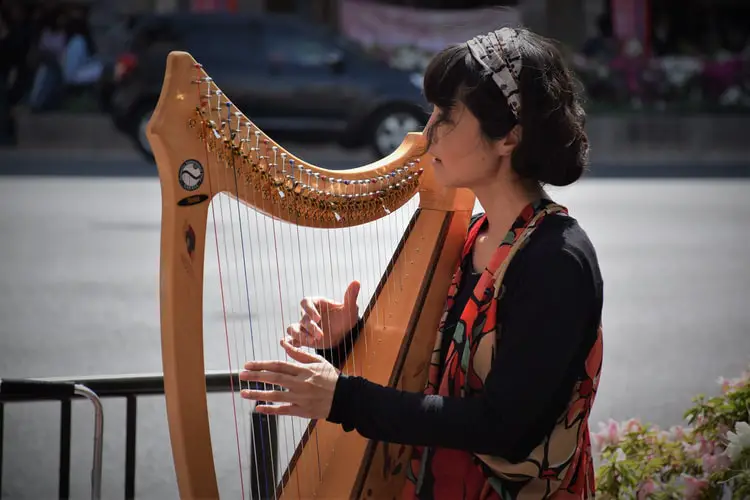What Muscles Are Required to Play the Harp? Exploring the Physical Demands
Folkstrings.com is reader-supported. When you buy through links on our site, we may earn a small commission.
Playing the harp involves a complex interaction between the musician and the instrument. It demands a unique blend of dexterity, strength, and coordination.
When playing the harp, I engage a series of muscles, particularly in my arms and hands. The flexor and extensor muscles in the forearm play a pivotal role. They control the finger movements necessary for plucking the strings accurately.
Maintaining the proper playing posture requires sustained engagement of the shoulder and back muscles. They support the arms and ensure precise control over the instrument.

The study and practice of harp performance not only involve learning the correct finger placements but also developing muscle memory for fluid and effortless playing.
Early in the learning process, it’s critical for me to focus on developing this muscle memory. It plays a significant role in the formation of my playing habits.
With the harp’s size and string tension, the fingers, wrists, and arms work together to produce the desired sound. Understanding the physicality behind harp playing is just as important as the musical aspects.
Key Points
- Muscle engagement is essential for precise plucking and finger movement.
- Developing muscle memory early aids in forming effective harp playing habits.
- Physical posture and finger techniques contribute significantly to playing the harp well.
Table of Contents
Fundamentals of Harp Playing
When I play the harp, I consider it essential to start with the basics of hand positioning and technique. The strings require a delicate touch, with each finger having its role.
I ensure my thumb stays high and relaxed while my fingers curve slightly, ready to pluck the strings with precision.
I pay special attention to my sitting posture. I balance my weight evenly and keep my back straight, which helps in maintaining proper hand positioning.
My feet are positioned so that one can easily reach the pedals without strain, if I’m playing a pedal harp.
Here’s a brief rundown of the techniques I bear in mind while playing:
- Plucking: Gently pulling and releasing the strings with fingertips.
- Hand Position: Curved fingers and a high thumb, all placed just right.
- Thumb: Always leading, it’s the highest point while playing a note.
- Fingers: I ensure they are curved inward, like holding a small ball.
Maintaining these fundamentals is crucial to prevent muscle and joint injuries which can arise from poor technique.
As for the harp itself, balance is key. Whether it’s the balance of the instrument as I sit or the way I distribute the harp’s weight on my shoulder, every aspect contributes to a fluid performance.
This allows for a seamless transition from one technique to another, enabling me to focus on musical expression rather than the discomfort that could arise from an unbalanced posture or incorrect hand positioning.
Learning and Practice
When I first decided to learn to play the harp, I knew that consistent practice was critical.
My harp teacher structured the lessons in a way that led me through the fundamentals like positioning and plucking each string with the correct finger.
I made it a point to start each session with warm-up exercises. These exercises are essential to building the finger and hand muscles needed for playing:
- Scales: I practice these to improve my finger dexterity.
- Arpeggios: These help me navigate the strings and increase coordination.
For beginners like me, mastering the basics came first. I went through a course that included proper hand placement and understanding notes.
Most harp teachers will emphasize the importance of muscle memory, so I made sure to practice pieces repeatedly.
Outside of formal classes, I supplemented my learning with various online resources:
- YouTube Videos: Watching harpists perform and teach on YouTube provided me with visual and auditory examples.
- Internet: I sought out tips and techniques from harp forums and websites.
- Books: They offered me in-depth understanding and diverse sheet music.
I also learned that speed in playing isn’t the goal; it’s about accuracy. As time passed, and I became more comfortable, my ability to interweave complex melodies improved.
Practice, both with a teacher and independently, has been my stepping stone to becoming proficient at playing the harp.
Musicality on the Harp
When I approach the harp, I am very much aware of the balance between technical muscle engagement and the flow of music.
Playing the harp involves a multitude of muscles, particularly in my fingers, hands, arms, and even my shoulders.
Mastering the dynamics and tone to create beautiful music is an art that requires precision and fluidity.
To get the nuances of a piece right, I need to adjust my touch. It fascinates me how the tension in my fingers can shift a note from piano (soft) to forte (loud), imbuing each chord with emotion.
Harps come in various types, and each harp requires a slightly different technique.
The lever harp, often used in folk and Celtic music, and the grand pedal harps, typically found in classical music, produce different sounds.
The lever harp has a more crisp and clear sound, encouraging deft finger work, while the pedal harp, with its intricate pedal system, allows for sophisticated chromaticisms and dynamic shifts.
When playing notes or chords, I focus on the evenness and clarity to let each note ring true.
In practice, I strive to blend the physical actions seamlessly with the music itself. Each gesture and pluck resonates not just within the instrument but within me, as a part of a harmonious dialogue between the harp and my own musical intention.
Harp Selection and Maintenance
When I choose my harp, I consider the type of music I want to play and the portability I need. Lever harps are ideal for beginners and folk music enthusiasts, being more lightweight and having levers to change the pitch of strings.
In contrast, pedal harps are larger, featuring pedals to adjust pitches and suitable for classical compositions due to their extensive range.
I always recommend a visit to a local music store or contacting reputable harp dealers to test different harps. It’s important to feel comfortable with the structure and range of the instrument.
Once I’ve selected my harp, maintenance is key. Tuning is a daily ritual for me.
I use a tuning key and start from the middle C, using the coloured strings as a guide – typically red for C and blue or black for F. Regular tuning maintains the harp’s sound quality and prolongs its life.
Here’s a simple checklist I follow for maintenance:
- Regular Tuning: Ensures the instrument remains harmonious.
- Dust-off: I use a soft cloth to keep the wood clean.
- String Replacement: I check for worn or damaged strings and replace them as needed.
- Temperature and Humidity Control: I keep my harp away from extreme conditions to prevent wood warping.
Frequently Asked Questions
In this section, I’ll address some of the questions you might have about the physical aspects of playing the harp and how to optimize your technique for both performance and practice.
What are the main physical requirements for harpists?
Playing the harp requires a blend of finger dexterity, arm strength, and overall endurance. I’ve found that maintaining a relaxed yet controlled posture is key to effectively transfer energy through my fingers to the strings.
How can I ensure proper hand technique when playing the harp?
To ensure proper hand technique, I keep my fingers relaxed and maintain a natural curve. I make sure to pluck the strings with a motion that originates from my finger joints, giving me precision and a delicate touch.
What are the common challenges when developing finger strength for harp playing?
One common challenge is avoiding tension which can lead to fatigue or injury. I focus on gradual strength building, using exercises tailored to enhance agility and power in my fingers without strain.
Are there specific warm-up exercises recommended for harp players?
Yes, there are. Specific warm-up exercises that help me include scales and arpeggios, which prepare my fingers for the demands of playing. They also assist in loosening my muscles and sharpening my focus.
How does hand movement affect the sound quality in harp playing?
The way I move my hands greatly affects sound quality. A fluid hand movement ensures a smooth transition between notes, while a sharp and precise plucking motion allows for clearer articulation.
In what ways does posture impact a harpist’s performance?
My posture directly impacts my performance. Sitting upright with my feet flat on the floor allows for better control and stability. This makes it easier to reach the strings and maintain accuracy during extended playing periods.
Author Profile
-
Daniel Johnstone is an English writer with a love for stringed instruments from around the world.
He shares his love for these instruments through his writing for folkstrings.com, a website dedicated to all things related to folk string music.
Daniel's passion for music started at a young age, and he has since become an accomplished musician, playing guitar, cavaco, and recently, the harp.
His dedication to learning and sharing his knowledge of stringed instruments is evident in his insightful and engaging blog posts. Whether you're a seasoned musician or a beginner, Daniel's writing is sure to inspire and entertain you.
When he's not playing music or writing, you can find Daniel exploring new instruments and seeking out new sounds to share with his readers.
Latest entries
 AutoharpApril 4, 2024What Is the Autoharp Made Of: Exploring Its Materials and Craftsmanship
AutoharpApril 4, 2024What Is the Autoharp Made Of: Exploring Its Materials and Craftsmanship AutoharpApril 4, 2024Is Autoharp Easy to Play? Unveiling the Truth for Beginners
AutoharpApril 4, 2024Is Autoharp Easy to Play? Unveiling the Truth for Beginners AutoharpApril 4, 2024What Is an Autoharp Worth? Your Guide to Pricing and Value
AutoharpApril 4, 2024What Is an Autoharp Worth? Your Guide to Pricing and Value AutoharpApril 4, 2024Are Autoharp and Zither the Same Thing? Unraveling String Instrument Myths
AutoharpApril 4, 2024Are Autoharp and Zither the Same Thing? Unraveling String Instrument Myths
Affiliates:
This post may contain affiliate links that at no additional cost to you, the site may earn a small commission. We only recommend products we would use ourselves and all opinions expressed on this site are our own.
Accuracy Advice:
While we strive to provide up-to-date and accurate information, the content in this article may not reflect the most current research or medical guidelines. We encourage readers to do further research and consult with professionals for more personalized advice.
Our Recommendations:
The products and services mentioned in any of our articles are recommended based on our independent research and personal experience. We are not sponsored by any company. We aim to suggest products and services we believe are of high quality and could be beneficial to our readers.



